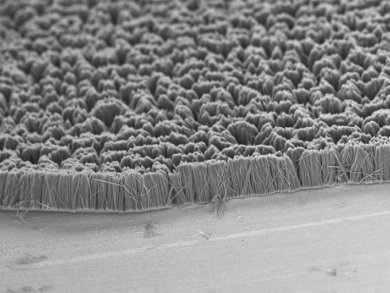Amorphous polymer materials are poor thermal conductors because their disordered state limits the transfer of heat-conducting phonons.
Virendra Singh, Thomas L. Bougher, Baratunde A. Cola, Georgia Institute of Technology, Atlanta, GA, USA, and colleagues have developed a thermal interface material which is able to conduct heat 20 times better than the original polymer. The new interface material is produced from the conjugated polymer polythiophene, in which aligned polymer chains in nanofibers facilitate the transfer of phonons – but without the brittleness associated with crystalline structures. This amorphous material can have a thermal conductivity of up to 4.4 W m–1K–1 at room temperaturhey. Samples of the material have been tested to 200 °C through 80 thermal cycles without any detectable difference in performance.
The structures are grown in a multi-step process that begins with an alumina template containing tiny pores covered by an electrolyte containing monomer precursors. When an electrical potential is applied to the template, electrodes at the base of each pore attract the monomers and begin forming hollow nanofibers. The amount of current applied and the growth time control the length of the fibers and the thickness of their walls, while the pore size controls the diameter. Fiber diameters range from 18 to 300 nm, depending on the pore template.
After formation of the monomer chains, the nanofibers are cross-linked with an electropolymerization process, and the template is removed. The resulting structure can be attached to electronic devices through the application of a liquid such as water or a solvent, which spreads the fibers and creates adhesion through capillary action and van der Waals forces.
The new thermal interface material could be used to draw heat away from electronic devices in servers, automobiles, high-brightness LEDs, and certain mobile devices. A patent application has been filed, and Cola has formed a startup company, Carbice Nanotechnologies, Atlanta, GA, USA, to commercialize thermal interface technologies.
Scanning electron microscope image showing vertical polythiophene nanofiber arrays
grown on a metal substrate. The arrays contained either solid fibers or hollow tubes,
depending on the diameter of the pores used to grow them. (©: Virendra Singh)
- High Thermal Conductivity of Chain-oriented Amorphous Polythiophene,
V. Singh, T. A. Bougher, A. Weathers, Y. Cai, K. Bi, M. T. Pettes, S. A. McMenamin, W. Lv, D. P. Resler, T. R. Gattuso, D. H. Altman, K. H. Sandhage, L. Shi, A. henry, B. A. Cola,
Nature Technol. 2014.
DOI: 10.1038/nnano.2014.44




